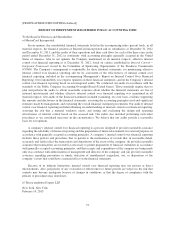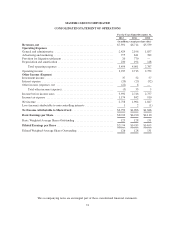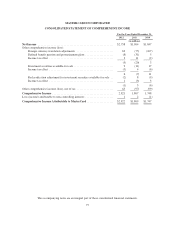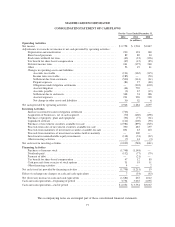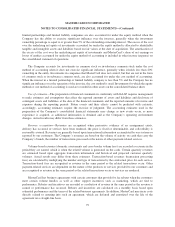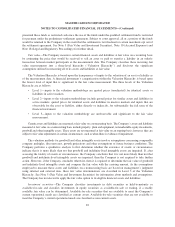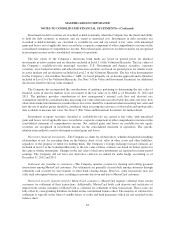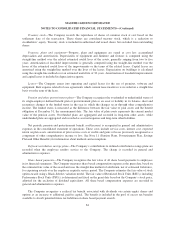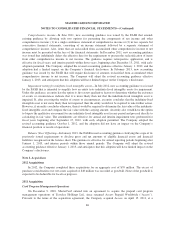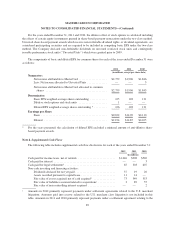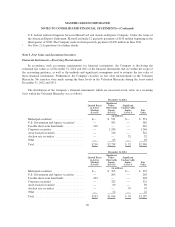MasterCard 2012 Annual Report Download - page 86
Download and view the complete annual report
Please find page 86 of the 2012 MasterCard annual report below. You can navigate through the pages in the report by either clicking on the pages listed below, or by using the keyword search tool below to find specific information within the annual report.MASTERCARD INCORPORATED
NOTES TO CONSOLIDATED FINANCIAL STATEMENTS—(Continued)
presented these funds as restricted cash since the use of the funds under the qualified settlement fund is restricted
for payment under the preliminary settlement agreement. Subject to court approval, all or a portion of the funds
would be returned to the Company in the event that the settlement is not finalized or certain merchants opt out of
the settlement agreement. See Note 5 (Fair Value and Investment Securities), Note 10 (Accrued Expenses) and
Note 18 (Legal and Regulatory Proceedings) for further detail.
Fair value—The Company measures certain financial assets and liabilities at fair value on a recurring basis
by estimating the price that would be received to sell an asset or paid to transfer a liability in an orderly
transaction between market participants at the measurement date. The Company classifies these recurring fair
value measurements into a three-level hierarchy (“Valuation Hierarchy”) and discloses the significant
assumptions utilized in measuring all of its assets and liabilities at fair value.
The Valuation Hierarchy is based upon the transparency of inputs to the valuation of an asset or liability as
of the measurement date. A financial instrument’s categorization within the Valuation Hierarchy is based upon
the lowest level of input that is significant to the fair value measurement. The three levels of the Valuation
Hierarchy are as follows:
• Level 1—inputs to the valuation methodology are quoted prices (unadjusted) for identical assets or
liabilities in active markets.
• Level 2—inputs to the valuation methodology include quoted prices for similar assets and liabilities in
active markets, quoted prices for identical assets and liabilities in inactive markets and inputs that are
observable for the asset or liability, either directly or indirectly, for substantially the full term of the
financial instrument.
• Level 3—inputs to the valuation methodology are unobservable and significant to the fair value
measurement.
Certain assets and liabilities are measured at fair value on a nonrecurring basis. The Company’s assets and liabilities
measured at fair value on a nonrecurring basis include property, plant and equipment, nonmarketable equity investments,
goodwill and other intangible assets. These assets are not measured at fair value on an ongoing basis; however, they are
subject to fair value adjustments in certain circumstances, such as when there is evidence of impairment.
The valuation methods for goodwill and other intangible assets involve assumptions concerning comparable
company multiples, discount rates, growth projections and other assumptions of future business conditions. The
Company performs a qualitative analysis to first determine whether the existence of events or circumstances
indicate that it is more likely than not that goodwill and indefinite-lived intangible assets are impaired. If, after
assessing the totality of events or circumstances, the Company concludes that it is not more likely than not that
goodwill and indefinite-lived intangible assets are impaired, then the Company is not required to take further
action. However, if the Company concludes otherwise, then it is required to determine the fair value of goodwill
and indefinite-lived intangible assets and compare the fair value with the carrying amount. As the assumptions
employed to measure these assets and liabilities on a nonrecurring basis are based on management’s judgment
using internal and external data, these fair value determinations are classified in Level 3 of the Valuation
Hierarchy. See Note 5 (Fair Value and Investment Securities) for information about methods and assumptions.
The Company has not elected to apply the fair value option to its eligible financial assets and liabilities.
Investment securities—The Company classifies investments in debt securities as held-to-maturity or
available-for-sale and classifies investments in equity securities as available-for-sale or trading, if a readily
available fair value can be determined. Available-for-sale securities that are available to meet the Company’s
current operational needs are classified as current assets. Available-for-sale securities that are not available to
meet the Company’s current operational needs are classified as non-current assets.
82


